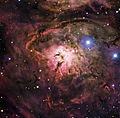Datoteka:Lagoon Nebula.jpg
Prijeđi na navigaciju
Prijeđi na pretragu

Veličina ovog prikaza: 610 × 599 piksela. Druge rezolucije: 244 × 240 piksela | 489 × 480 piksela | 782 × 768 piksela | 1.043 × 1.024 piksela | 1.841 × 1.808 piksela.
Izvorna datoteka (1.841 × 1.808 piksela, veličina datoteke/fajla: 2,92 MB, MIME tip: image/jpeg)
Historija datoteke
Kliknite na datum/vrijeme da biste vidjeli tadašnju verziju datoteke.
| Datum/vrijeme | Minijatura | Dimenzije | Korisnik | Komentar | |
|---|---|---|---|---|---|
| aktualna | 02:20, 4 mart 2014 |  | 1.841 × 1.808 (2,92 MB) | Lmbuga | Putting the nebula in the center of the image |
| 09:48, 9 august 2012 |  | 2.027 × 2.064 (1,59 MB) | Fabian RRRR | higher resolution | |
| 09:32, 22 april 2010 |  | 1.280 × 1.303 (317 kB) | EricHS211 | {{Information |Description={{en|1=Infrared view of the Cat’s Paw Nebula (NGC 6334) taken by VISTA. NGC 6334 is a vast region of star formation about 5500 light-years from Earth in the constellation of Scorpius. The whole gas cloud is about 50 light-year |
Upotreba datoteke
Sljedeća stranica koristi ovu datoteku:
Globalna upotreba datoteke
Ovu datoteku upotrebljavaju i sljedeći projekti:
- Upotreba na projektu ady.wikipedia.org
- Upotreba na projektu alt.wikipedia.org
- Upotreba na projektu av.wikipedia.org
- Upotreba na projektu bn.wikipedia.org
- Upotreba na projektu cs.wikipedia.org
- Upotreba na projektu cv.wikipedia.org
- Upotreba na projektu de.wikipedia.org
- Upotreba na projektu en.wikipedia.org
- Upotreba na projektu et.wikipedia.org
- Upotreba na projektu fr.wikipedia.org
- Upotreba na projektu hu.wikipedia.org
- Upotreba na projektu kaa.wikipedia.org
- Upotreba na projektu kk.wikipedia.org
- Upotreba na projektu koi.wikipedia.org
- Upotreba na projektu ko.wikipedia.org
- Upotreba na projektu kv.wikipedia.org
- Upotreba na projektu lez.wikipedia.org
- Upotreba na projektu mdf.wikipedia.org
- Upotreba na projektu mg.wikipedia.org
- Upotreba na projektu mk.wikipedia.org
- Upotreba na projektu mrj.wikipedia.org
- Upotreba na projektu olo.wikipedia.org
- Upotreba na projektu os.wikipedia.org
- Upotreba na projektu pl.wikipedia.org
- Upotreba na projektu pt.wikipedia.org

